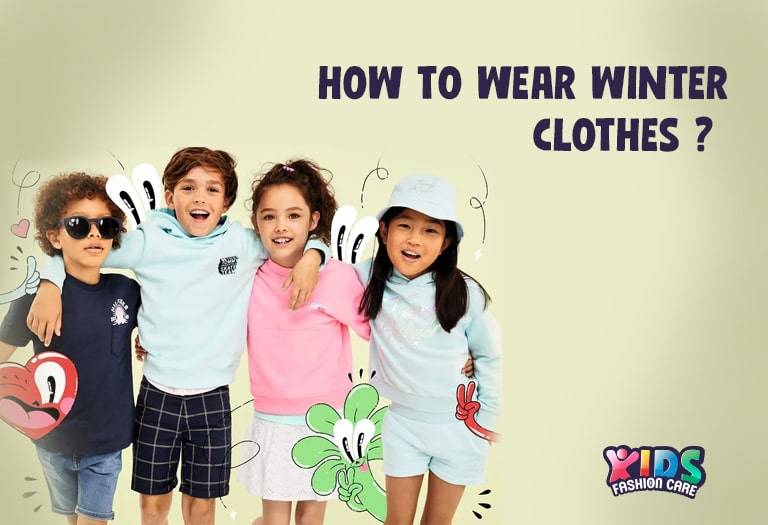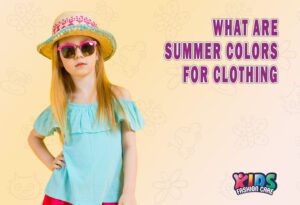Start with a base layer made of merino wool or thermal sweater. For the mid layer, go for fleece jackets or thick sweaters, as they provide excellent warmth. Finish the outer layer with an insulated jacket or a water-resistant and windproof jacket.
Table of Contents
My kids and I love winter. Winter is fun and cozy, and we enjoy all kinds of winter activities. Dressing up my kids in different winter clothes is one of my favorite things. I love finding ways to keep them warm, comfortable, and stylish all at the same time. In this blog, I’ll share with you how I dress my kids for winter. I hope my tips will help you dress your kids as well. Also, if you’re a new parent, this guide will be especially beneficial for you, because I’m also going to cover how to wear winter clothes for babies as well.
How to Dress for Winter?
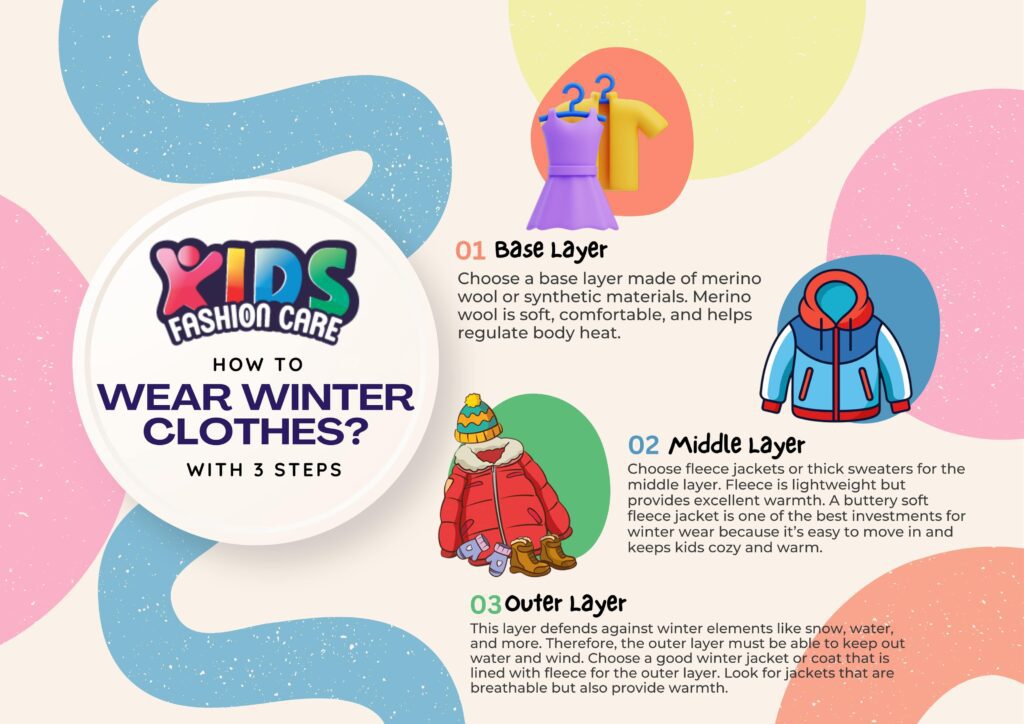
Layering is essential when it comes to dressing kids in winter. Layers trap heat and keep cold air out. In winter, layers also help regulate a child’s body temperature. So, if you want to keep your kids warm in cold temperatures, layers are a must. You have to use the right layers in the right order if you don’t want to make your kids feel bulky. For my kids, I prefer 3 layers, and they are good to go.
- Base Layer: Base layer is the first and most important layer. It’s the one closest to the skin and needs to be moisture-wicking to pull sweat away from the body. I always choose a base layer made of merino wool or synthetic materials. Merino wool is soft, comfortable, and helps regulate body heat. I also choose synthetic options from time to time. I think synthetic fabrics are better because they last longer and cost less.
- Middle Layer: The middle layer is important because it keeps the heat inside. What’s in the middle helps keep the warmth in and the cold out. For my kids, I often go for fleece jackets or thick sweaters. Fleece is lightweight but provides excellent warmth. A buttery soft fleece jacket is one of the best investments for winter wear because it’s easy to move in and keeps kids cozy and warm.
- Outer Layer: This layer defends against winter elements like snow, water, and more. Therefore, the outer layer must be able to keep out water and wind. For my kids, I always make sure they have a good winter jacket or coat that is lined with fleece. The insulating materials to help to keep the cold wind, rain, and snow out. When picking an outer layer, I look for jackets that are breathable but also provide warmth, especially on days when temperatures drop significantly.
Cold Weather Clothing Guide
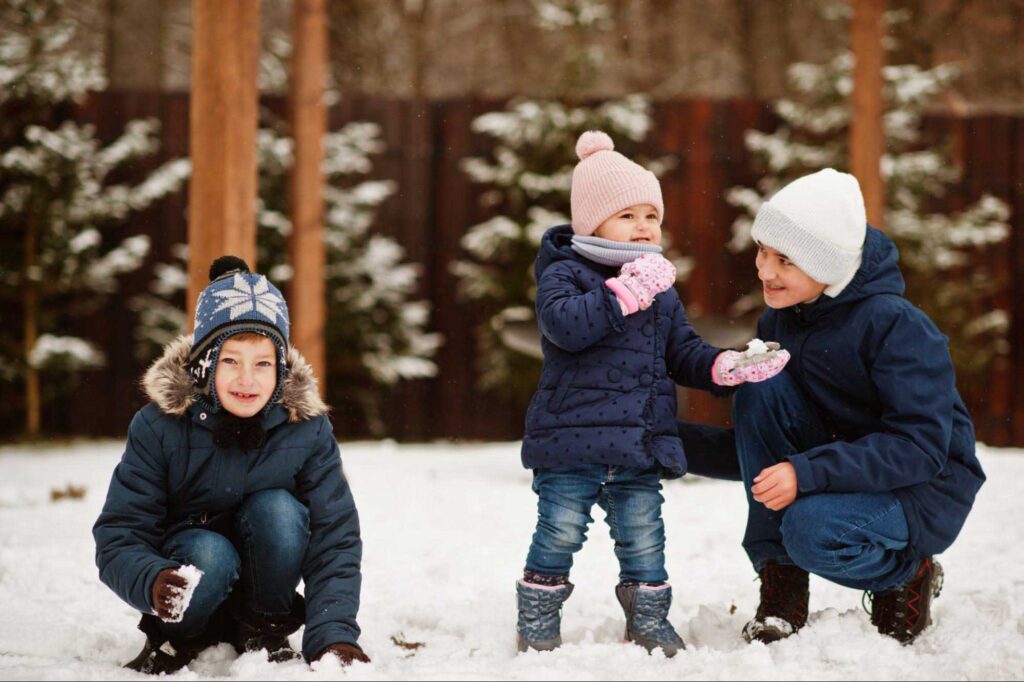
Thermal Leggings
These are a must for keeping my kids’ legs warm. I layer thermal leggings under their regular pants, which allows them to stay warm without feeling bulky. For really cold days, I sometimes add an extra layer of leggings to keep them extra cozy.
Long Sleeve Shirts
These are perfect for layering. I prefer thin but warm long-sleeve shirts as the base layer and then add a sweater or fleece on top.
Sweater Dresses and Midi Dresses
For my daughter, I often dress her in sweater dresses or midi dresses with thermal leggings underneath. Paired with knee-high boots, these outfits are both stylish and practical for winter.
Water-resistant Boots
Keeping my kids’ feet warm and dry is crucial, so I always choose water-resistant boots. For extra cold days, I opt for knee-high boots, and for milder winter days, ankle boots with thick socks work just fine.
Thick Socks
Whenever I choose socks for my kids I prefer wool and fleece. The best part of wool and fleece is they help to keep the feet warm throughout the day. Even when my kids play outside I prefer them wearing wool or fleece socks.
Fabrics for Winter
Choosing the right fabrics for winter is very important. Some fabrics, like cotton, absorb moisture and can make your child feel cold if they sweat. I’ll discuss some winter-friendly fabrics and they are also trendy.
Merino Wool
This is my go-to for base layers. It’s natural, soft, and great at keeping kids body temperature steady. It also naturally wicks away moisture, so my kids stay dry even if they sweat a bit.
Fleece
Fleece is great for middle layers. It’s very light, but it keeps kids very warm in winter. This material dries quickly after getting wet, which makes it great for active kids.
Natural Fibers
Natural fibers like wool and others are great at keeping heat in. So kids stay warm and dry, since they keep heat in and let moisture out.
Synthetic Materials
Many synthetic materials, like polyester, are great for outer layers because they are durable and water-resistant. They can also be found in blends with other fabrics, providing warmth and flexibility.
How to Dress Kids from Different Age Groups?
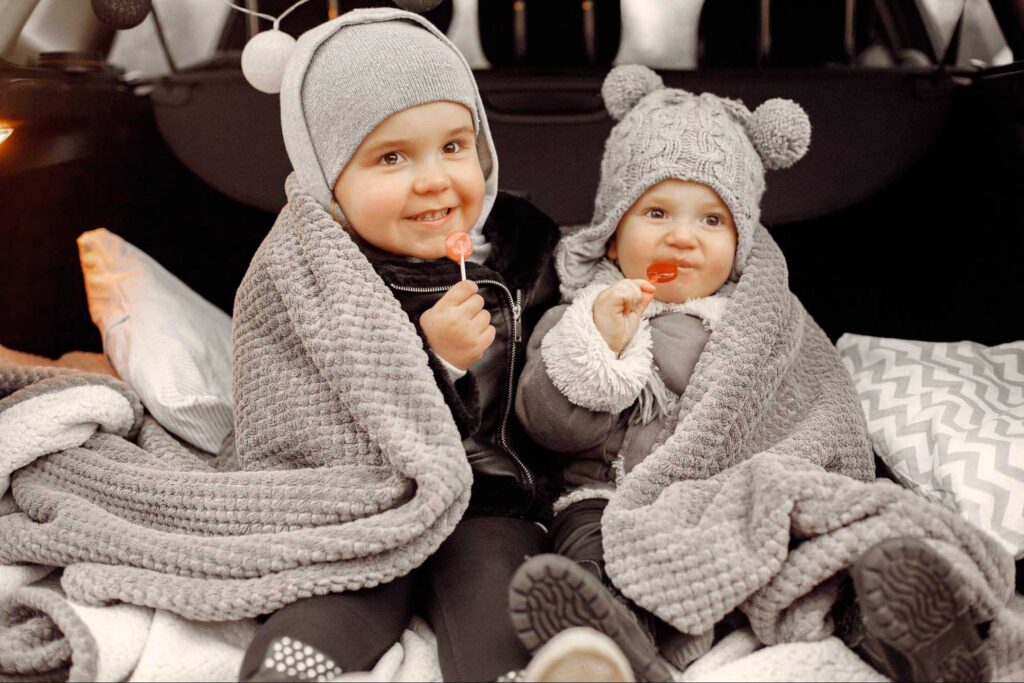
Dressing kids for winter varies depending on their age, activity level, and needs.
Newborn
Newborns are especially vulnerable to cold because they can’t regulate their body temperature well. Here’s how I used to dress my kids when they were babies.
Layering
In order to keep my kids warm and cozy, I started with a soft base layer like a onesie made from cotton or merino wool. A full-body sleeper or thermal suit was another thing I used to wear in the middle.
Warm outerwear
A fleece-lined or insulated snowsuit will help keep your newborn warm and dry when outdoors. Make sure it’s not too tight to allow movement.
Accessories
I used to use a winter hat that covers their ears, mittens, and thick socks to protect their extremities.
Tips: Because newborns don’t sweat much, be careful not to get too hot. Make sure they are not too hot by touching their neck or chest.
Toddler
Toddlers are very active and like to move around, so their clothes should be comfortable and easy to move in.
Layering
I used to dress my toddlers in thermal leggings or base layers under their regular clothes to retain body heat. You can use long-sleeved shirts and pants as the middle layer.
Outerwear
Choose a water-resistant coat or jacket that is thick but still allows your toddler to run and play. Puffer jackets and snowsuits are my picks. They are good choices for outerwear.
Footwear
Waterproof ankle boots or knee-high boots with a good grip are ideal to keep their feet warm and dry.
Accessories
Make sure they wear mittens, a winter hat, and a scarf to protect them from the cold wind. Opt for fleece-lined items for extra warmth.
Tips: Toddlers can get messy, so it’s a good idea to dress them in layers that are easy to remove for quick changes when needed.
Preschooler
At preschool kids start to build their opinion. They are more independent and can express their clothing preferences, but keeping them warm and comfortable is still essential.
Layering
Dress them in comfortable base layers like thermal leggings or tights under their pants, paired with a long-sleeve shirt. You can add a sweater dress or a fleece pullover for extra warmth.
Outerwear
Opt for a durable, insulated jacket or parka with insulation layers to protect them from the cold. If they’re playing in the snow, snow pants are essential.
Footwear
Preschoolers need sturdy winter boots that are water-resistant and insulated to keep their feet warm during outdoor play. Add thick socks to prevent cold toes.
Accessories
Don’t forget mittens, scarves, and hats. Let them choose fun patterns or colors to make dressing for winter more exciting.
Tips: Kids in preschool can start to learn how to dress themselves. To make getting dressed easier for them, choose clothes with zippers or Velcro.
Teenager
Teenagers become more aware of how they look when they reach that age. When teens want to look good and stay warm at the same time, it’s important to choose winter clothes that are both practical and stylish.
Layering
Tell your teens to put on base layers like thermal tops that wick away sweat and leggings before their regular clothes. No extra bulk is needed because this will keep them warm.
Outerwear
It is important to have a stylish winter jacket that keeps teens warm. Look for coats that are both stylish and useful because they will keep them warm in cold weather. Warm coats made of wool or puffer jackets work well.
Footwear
Teenagers might like trendy boots like combat boots or ankle boots. Make sure they don’t let water in so their feet stay dry in snow or rain.
Accessories
Winter hats, scarves, and gloves can be styled to fit the teen’s personality. Assist them wearing long coats and extra layers like hoodies to stay warm.
Tips: Assist your teenager in figuring out how to stay warm without compromising fashion. For example, you could wear a sweater dress with stylish boots or layer a midi dress over thermal leggings.
Cold Weather Clothes List
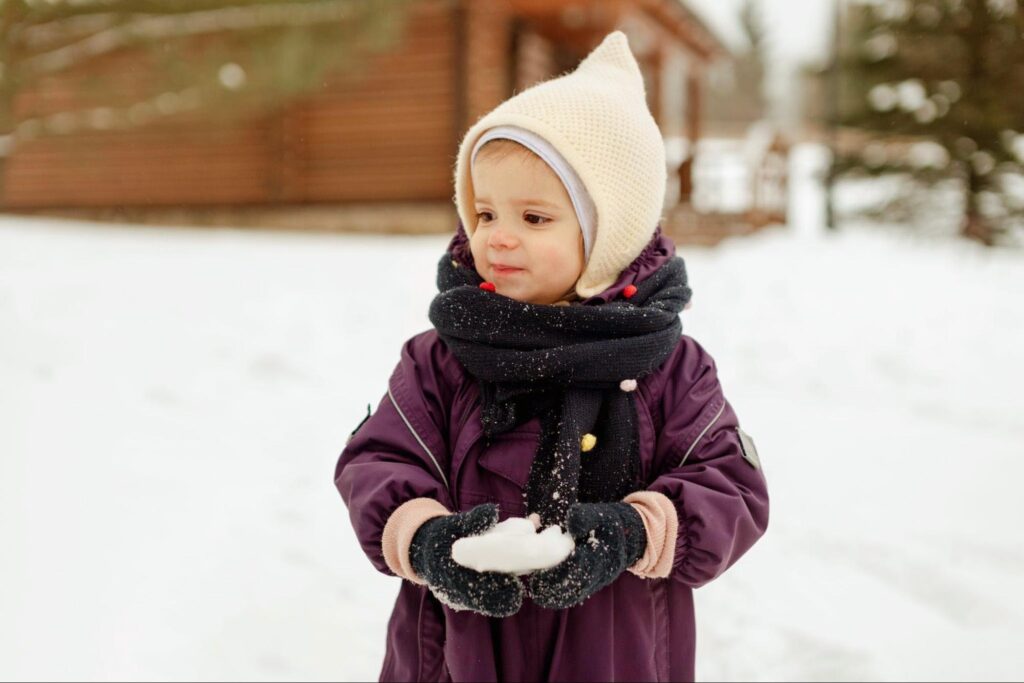
Here’s a list of winter essentials that I never skip when dressing my kids for the cold:
Thermal Leggings or Pants
Thermal leggings or pants are best to keep kids’ legs warm. They are not heavy and feel light to the skin. These keep their legs warm even in freezing temperatures. With thermal leggings or pants are also great for winter activities.
Snow Pants
Snow pants are wind and water resistant. They are also waterproof with an insulating down or synthetic fill inside. For winter outdoor activities snow pants are a must.
Long Sleeve Shirts and Sweater Dresses
Long sleeve shirts and sweater dresses are great for layering and keeping kids’ upper body warm. These pieces of clothes are fashionable, and the best part is you can layer them up.
Thick Socks
You can forget the feet! As I already said that keeping kids feet warm is important and a pair of good thick socks are essential for keeping kids feet warm and dry. You can choose wool or fleece-lined socks to keep their feet toasty.
Knee-high Boots or Ankle Boots
While shopping for footwear for winter make sure they’re water-resistant to protect from snow or rain. Knee-high boots or ankle boots are popular choices in winter for kids.
Winter Hat and Mittens
As kids’ heads and hands get cold quickly like their feet so you have to pay some extra attention to them too. Winter hats and mittens are essential to protect kids’ extremities from the cold. I always keep an extra pair of mittens in my bag as my kids can go clumsy sometimes.
Extreme Cold Weather Clothing
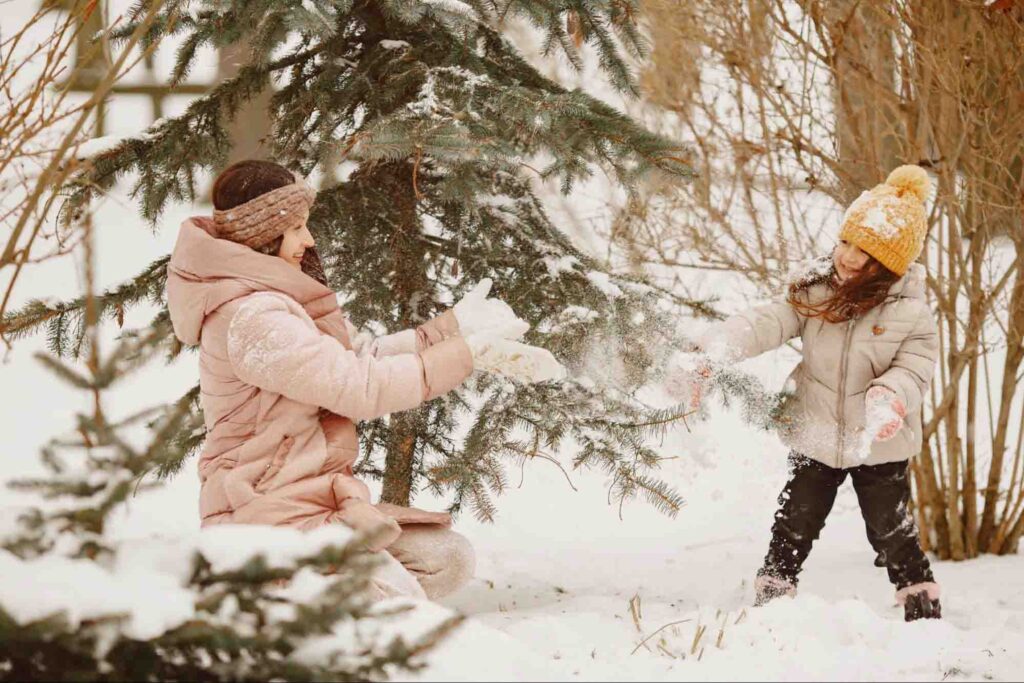
When the weather turns really cold, layering becomes even more important. Follow these 3 steps to keep your kids warm in extreme cold weather.
- Start with Thermal Underwear
A good pair of thermal leggings and a matching long-sleeve top will add extra warmth, and the best part is they will not add any bulk.
- Add an Insulated Middle Layer
For extreme cold, I go for heavier fleece or even down jackets as a middle layer for my kids. I choose them, because they trap more heat and provide the insulation needed when temperatures drop below freezing.
- Finish with a Heavy-duty Outer Layer
For extremely cold days, I use full-length coats that offer better coverage. These are often filled with down or other insulating materials that provide excellent protection against the cold.
Warm Clothes for Indoors
Not only outside, even indoors, it’s important to keep kids warm during the colder months. Here’s how I dress my kids to stay warm indoors.
Fleece-lined Pants
Fleece-lined pants are great to wear indoors. They’re warm but lightweight.
Sweaters
I opt for buttery soft sweaters that are easy to wear and provide just enough warmth for being inside.
Cozy Socks
Thick, cozy socks are a must, especially if your home has tile or hardwood floors that get chilly in winter.
Best Shoes and Socks for Winter
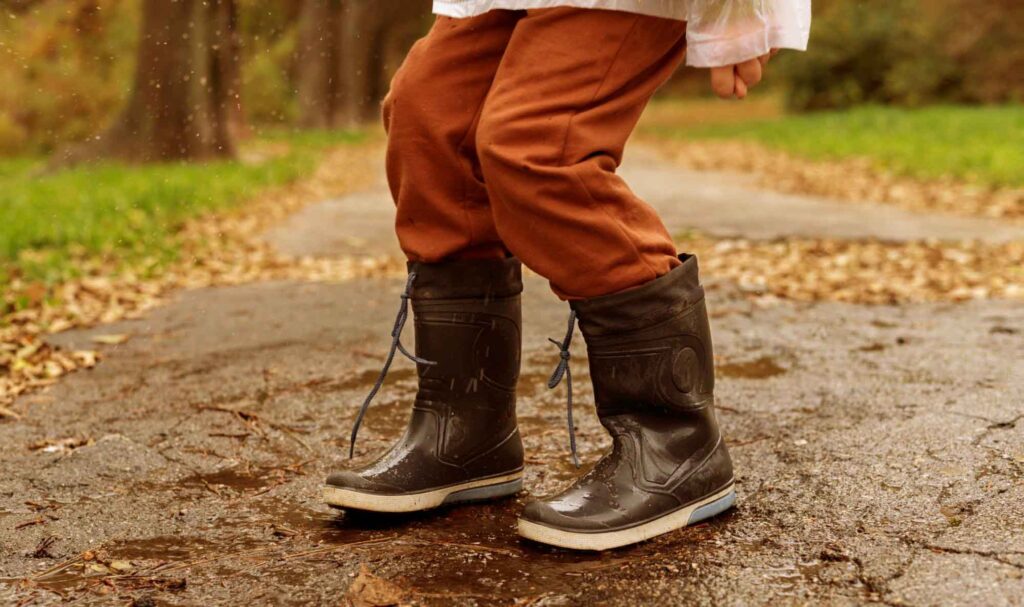
Winter footwear is not just about keeping feet warm—it’s about keeping them dry, too. Here’s how I ensure my kids’ feet are protected all winter long:
Water-resistant Boots
Whether ankle boots or knee-high boots, the most important feature is that they’re water-resistant. Wet feet make for cold feet, and a good pair of boots can make all the difference.
Thick Socks
I always pair their boots with thick socks, usually made of wool or fleece. These help to keep their feet warm and dry, even on snowy days.
Balancing Comfort with Style
Winter doesn’t mean your little ones have to sacrifice style. With some clothing items and combinations I balance comfort and style for my kids.
Sweater Dresses
My daughter loves wearing sweater dresses with leggings and boots. It’s a stylish but practical look that works well for colder weather.
Layering Stylish Pieces
Pairing a long sleeve shirt with a fleece jacket and a bright, fun scarf is an easy way to keep things stylish yet warm.
Colors and Patterns
Adding colorful scarves, hats, and gloves can make a simple winter outfit pop. I like to mix in bold colors to keep things fun.
Additional Layering for Cold Weather
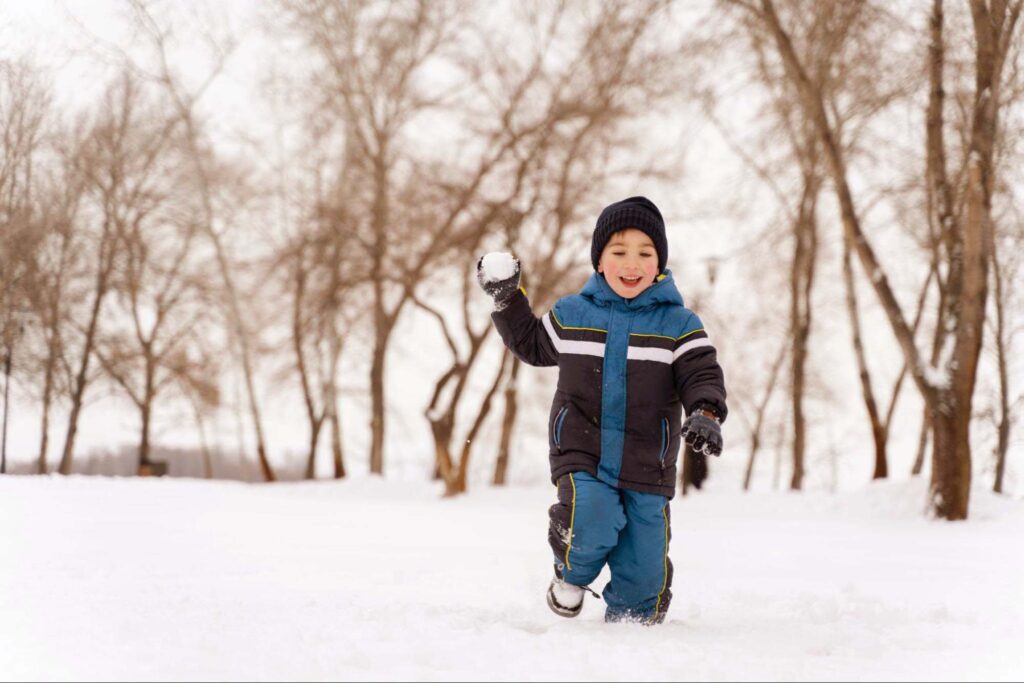
Sometimes, you need a bit more layering to keep the cold at bay. Here are a few extra tips I use:
Thermal layers
Always start with thermal underwear. It makes a big difference without adding bulk.
Double up on socks
On extremely cold days, I sometimes have my kids wear two pairs of socks. But, in that case you have to make sure the boots aren’t too tight.
Extra scarves and mittens
Adding a second pair of mittens or an extra scarf can help protect against biting winds.
Colors for Winter for Kids Clothing
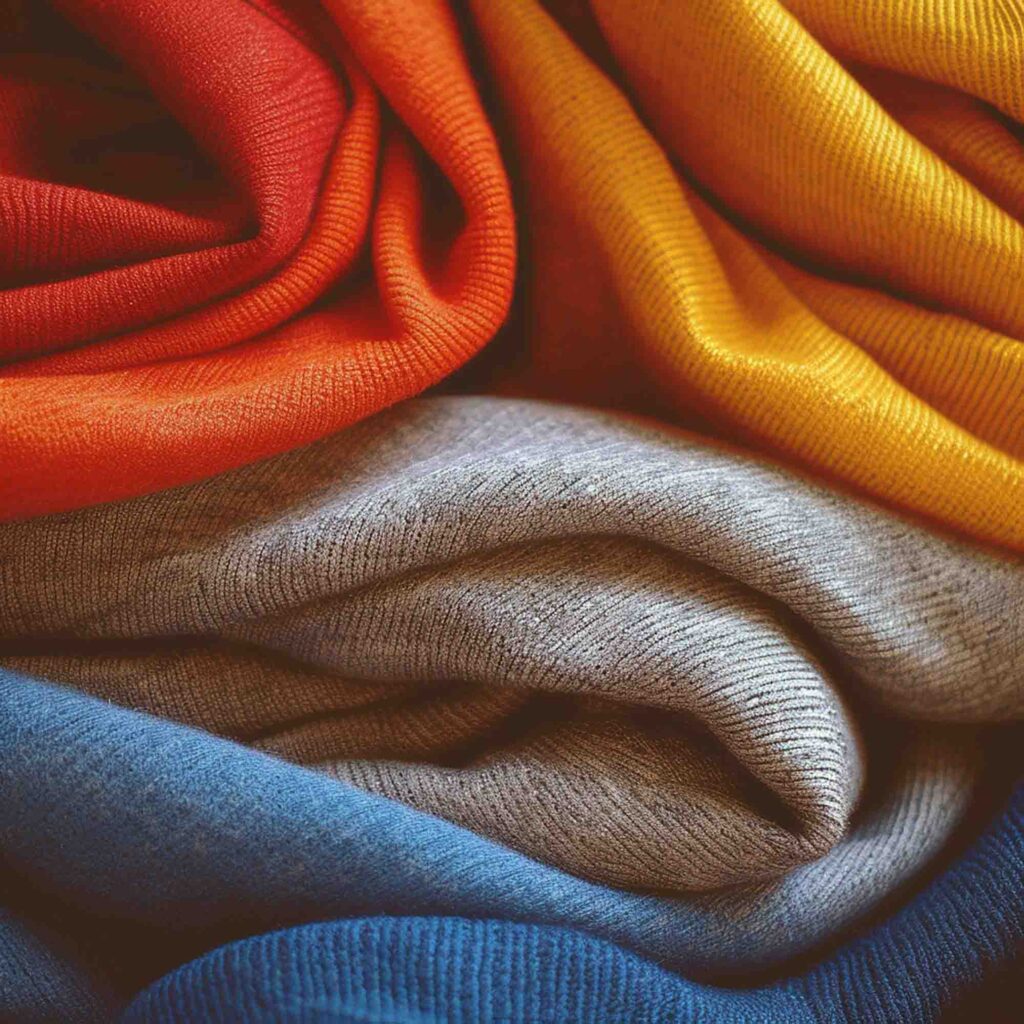
Winter clothing doesn’t have to be dull and gray. I love incorporating bright colors into my kids’ wardrobes. Choosing the right colors for your kids’ winter clothing can make a big difference in how they feel and look during the colder months.
Classic Winter Colors
- Navy Blue: Winter coats, jackets, and sweaters look fantastic in shades of navy, which is a classic and adaptable color. It adds polish and is simple to match with other colors.
- Deep Red: A rich red color can add warmth to your child’s outfit. It’s perfect for outerwear like jackets, winter hats, or scarves, and brings festive winter vibes.
- Forest Green: This shade is earthy and cozy, a great option for jackets or sweaters. It pairs well with neutrals like gray or beige.
- Charcoal Gray: A dark gray is a sophisticated color that keeps clothes looking clean longer, especially for active kids. It’s great for base layers and outerwear.
Bright and Fun Colors
- Bright Yellow: If your kids like a pop of color, bright yellow can be cheerful and fun, especially for rain jackets, boots, or winter hats. It also adds visibility during dark winter days.
- Bold Pink: For girls’ winter apparel, pink is a popular option. A warm, comfortable pink fleece or puffer jacket adds a pop of color to any winter ensemble, from coats to mittens.
- Royal Blue: A vibrant blue is another great color for kids’ winter wear. It can make jackets, snow pants, and boots more exciting and lively.
Neutrals and Earth Tones
- Cream or Off-White: Light neutrals like cream or off-white offer a soft, clean look. These colors work well in sweaters, mittens, and extra layers, but be mindful that they might show dirt more easily.
- Beige and Brown: Beige or light brown are examples of earth tones that can create a warm, natural look that goes well with long sleeve shirts, boots, and jackets. Additionally, these hues go nicely with more colorful accessories.
Patterns with Winter Colors
Adding patterns in traditional winter colors can add fun to your children’s wardrobes. Their winter outfits are given a playful twist by the addition of plaids, stripes, and animal prints in colors like red, green, navy, or gray.
Metallic Accents
For an extra stylish touch, metals like gold, silver, or bronze can be used in winter accessories, such as boots, winter hats, or scarves. These accents add a unique, eye-catching element to winter outfits.
Dark and Bold Colors for Teenagers
- Black: Black is elegant and can be versatile when worn with coats and knee-high or ankle-boot boots.
- Burgundy: This is another classic shade, which is perfect for the winter season especially in sweaters or exclusive wears.
- Olive Green: Olive is fashionable for jackets and full length coats, it is as fashionable as forest green, a good choice of material.
That is why I always make sure to make my kids to incorporate the rather bland neutral shades with more bright and cheerful ones to achieve a rather vibrant winter outfit
Patterns for Clothes in Winter
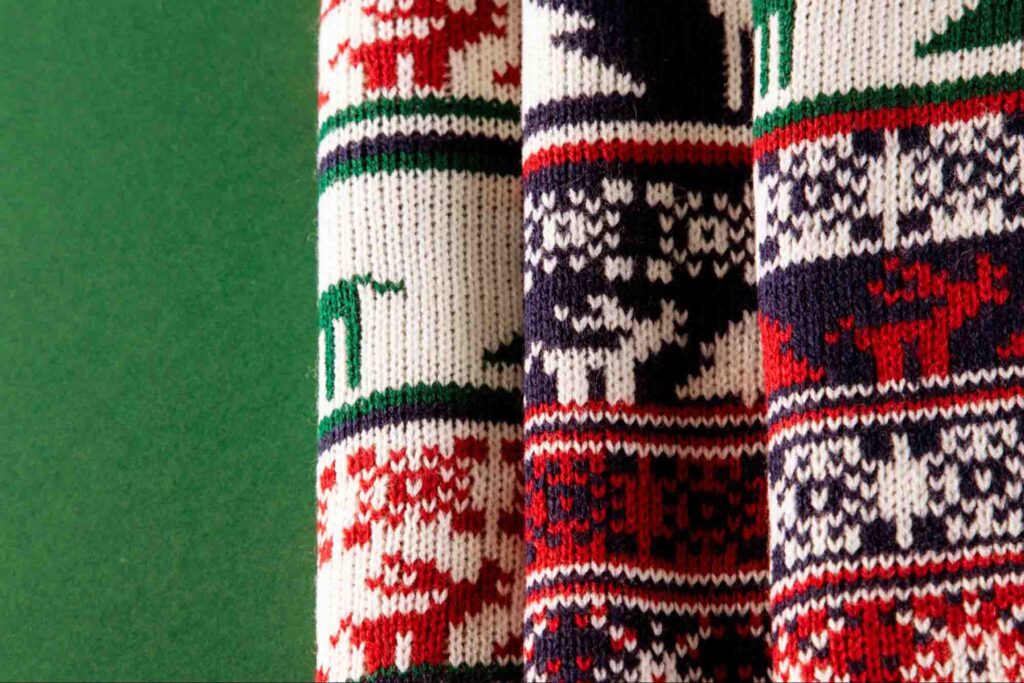
Adding patterns to your children’s winter wear is a great way to express their individuality. Here are a few popular winter designs that complement a variety of age groups and personal tastes.
Plaid
Plaid is one of the most universal winter patterns. This pattern is perfect for flannel shirts, jackets, and scarves. You can select the type of intersecting lines in durable colors such as red, green or blue so as to offer a warm style.
Plaid can be a versatile choice for winter clothing as it looks great when worn by toddlers as well as teenagers.
Stripes
For children’s apparel, stripes are a classic choice, particularly for cozy sweaters, long-sleeve shirts, and leggings in winter. They may be understated with pastels like gray and blue or striking with primary hues like yellow and red.
Winter attire may benefit from the addition of both horizontal and vertical stripes. While horizontal stripes are more fun, vertical ones might make you seem slimmer.
Fair Isle
Fair Isle is a classic winter pattern originating from Scotland. You will often see them in sweaters, mittens, and hats. It features geometric shapes like snowflakes, diamonds, and zigzags in multiple colors.
Most of the time, fair Isle uses more than one color, like red, blue, and white. This makes clothes for kids look lively and happy.
Polka Dots
Polka dots are a simple and fun pattern that can make winter clothes like jackets, sweaters, and dresses look better. They come in a range of sizes and colors, from simple black and white to bright mixtures.
Dresses or tops with polka dots can be worn under plain coats or jackets to make them more interesting without being too much.
Geometric Patterns
Older kids and teens like geometric patterns like triangles, hexagons, and other forms that aren’t quite real. You can find these designs on coats, boots, and sweaters.
Patterns with geometric shapes can be bold or soft, based on the color scheme. So, with geometric patterns you’ll have a versatile option for winter clothing.
Stars and Space Themes
Star patterns or space-themed designs, featuring planets and rockets, are great for kids who love adventure. These fun, whimsical patterns are common on winter pajamas, hats, and coats.
Accessorizing in The Cold
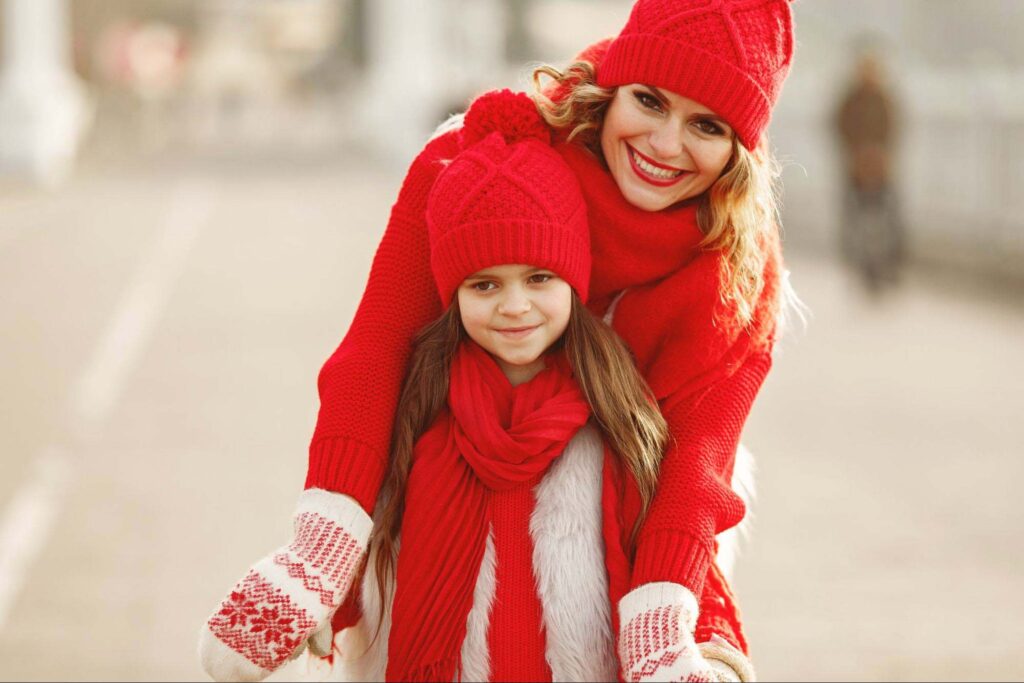
Winter hat
Children need a warm winter hat to keep their heads warm. For extra warmth, I like hats that cover my kids’ ears.
Scarves
I always make sure my kids wear scarves to keep their necks warm and protected from the cold wind.
Mittens or gloves
Mittens are warmer than gloves, but gloves offer more dexterity. I keep both options on hand depending on the activity.
Winter Fashion Tips
Choose the Right Size
Make sure their clothes fit well but aren’t too tight. Tight clothes can restrict movement and limit the insulation layer’s effectiveness.
Go for Quality over Quantity
It’s best to have some quality pieces in kids’ winter wardrobe rather than quantity. A few well-made, insulating materials will keep your kids warmer than several cheap layers. I always buy some good quality winter wear for my kids as it’s easier to organize their closet with a few great winter wear. Always remember, Less is More!
Mix and Match
You are free enough to play with colors when it comes to kids’ outfits. Have fun with colors and patterns to keep your kids’ winter wardrobes exciting and fun.
Frequently Asked Questions (FAQs)
Question: How to wear less layers in cold weather and not get cold?
Answer: If your child doesn’t like wearing many layers, here’s a trick: For warmth but non-bulky fabrics, it is recommended to seek good quality fabrics. Further, can reduce the number of layers needed by using Merino wool base layers and also flock lined outer garments such as jackets with sheepskin lining. It also provides additional warmth to wear thermal layers so they don’t need many layers on the outside.
Question: How to layer clothes in winter?
Answer: To layer clothes in winter, use the base layer that is thermal leggings or the long sleeve shirt to retain body heat. After that, you should layer it up with insulating clothing like a sweater in between. Last but not the least, the outer layer consists of a coat or jacket which will safeguard you from the cold wind and ensure that you are warm and dry.
Question: How many layers should a baby wear in cold weather?
Answer: A baby needs to wear one more layer than an adult would wear in the same weather. Start with a soft base layer, add a cozy middle layer like a fleece sweater, and finish with a warm outer layer, like a snowsuit or jacket. Don’t forget a hat and socks to keep them cozy!
Question: What do you wear on your head to keep warm in winter?
Answer: If you are going to be outside, make sure you wear a hat to keep your head warm in the winter especially if you are wearing wool or fleece clothing. It covers the head and ears to insulate you from the cold wind besides confining your body heat. If you want more warmth, you can put on a scarf around your neck as well.
Conclusion
Dressing kids for winter is all about smart layering and choosing the right materials. I hope tips from my personal experience help you dress your kids this winter with confidence. Remember, you can always dress your kids warm in winter stylishly.
Now, you know how to wear winter clothes for kids, keeping them warm, cozy, and stylish all winter long. You can also check Smart Storage Solution: How to Store Winter Clothes for Kids out, where I discussed storing ideas of kids’ winter clothes in detail.

